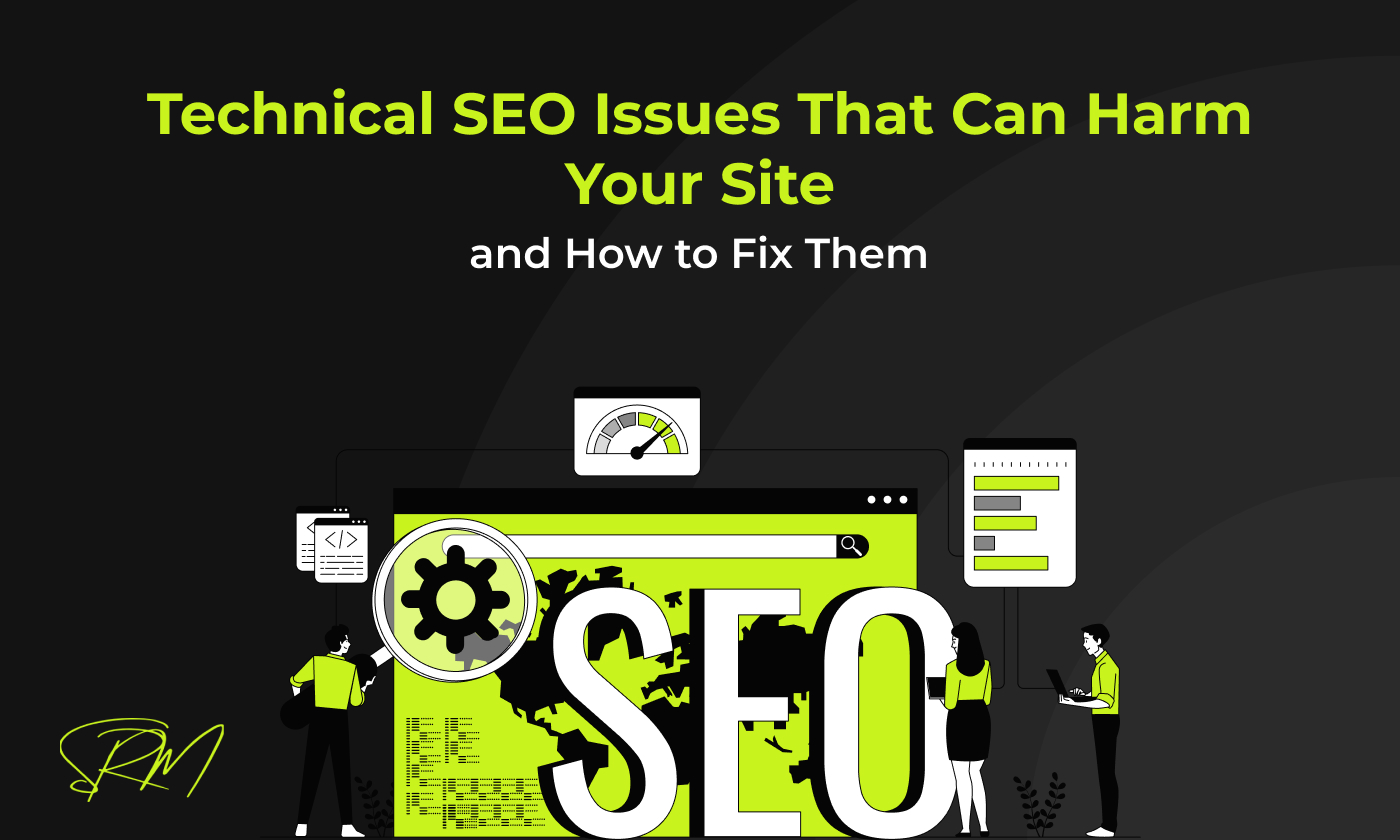
Imagine having a beautifully designed website with high-quality content, but it still fails to rank on Google. Frustrating, right? Many businesses face this issue, and the culprit is often technical SEO problems that prevent search engines from properly crawling and indexing their pages. Ignoring these issues can lead to poor rankings, low traffic, and missed opportunities.
In this guide, we’ll discuss the most common technical SEO issues, their impact on your site, and how to fix them effectively. Plus, provide a technical SEO audit checklist to help keep your website in top shape.
What is Technical SEO?
Technical SEO refers to the process of optimizing a website’s backend structure and technical elements to help search engines crawl, index, and rank it more efficiently. Unlike on-page SEO (which focuses on content) or off-page SEO (which involves backlinks), technical SEO deals with site speed, mobile-friendliness, structured data, security, and other factors that impact search performance.
A well-optimized technical SEO foundation ensures that search engines can understand and display your content effectively, leading to better visibility and higher rankings.
1. Slow Website Speed
Page speed is a major ranking factor for Google. A slow-loading website frustrates users and increases bounce rates, leading to lower rankings and poor user engagement.
How to Fix It:
- Optimize Images: Use compression tools like TinyPNG, ShortPixel, or WebP format to reduce image file sizes without compromising quality.
- Enable Browser Caching: This helps store static elements, reducing load times for returning visitors.
- Use a Content Delivery Network (CDN): A CDN distributes your website’s content across multiple global servers, enhancing loading speed.
- Minimize HTTP Requests: Reduce unnecessary scripts, stylesheets, and plugins that slow down site performance.
- Leverage Lazy Loading: Delay loading non-essential elements like images and videos until users scroll to them.
2. Google Indexing Issues
If your website isn’t being indexed properly, it won’t appear in search results, making it invisible to potential visitors.
How to Fix It:
- Use Google Search Console: Check for indexing errors under the “Coverage” report.
- Review Robots.txt File: Ensure your robots.txt file isn’t blocking important pages from being crawled by search engines.
- Submit an Updated XML Sitemap: An XML sitemap helps search engines understand your site structure and index pages correctly.
- Use the URL Inspection Tool: Request Google to index important pages manually.
- Check for Crawl Errors: Use tools like Screaming Frog SEO Spider to identify pages that are blocked from crawling.
3. Duplicate Content
Duplicate content confuses search engines, diluting your ranking potential and leading to penalties or de-indexing of pages.
How to Fix It:
- Implement Canonical Tags: Use the <link rel=”canonical”> tag to indicate the preferred version of a page.
- Use 301 Redirects: Redirect duplicate URLs to the original page.
- Check for Duplicate Content: Use tools like Copyscape, Siteliner, or Ahrefs to find and eliminate duplicate content.
- Avoid URL Variations: Ensure that different URL formats (HTTP/HTTPS, www/non-www) do not create duplicate pages.
4. Broken Links and Redirect Errors
Broken links create a poor user experience and signal to Google that your site is not well-maintained, potentially hurting rankings.
How to Fix It:
- Identify Broken Links: Use Google Search Console, Screaming Frog, or Ahrefs to detect broken links.
- Update or Remove Dead Links: Fix internal links leading to non-existent pages or remove them.
- Set Up 301 Redirects: Redirect outdated URLs to relevant, active pages.
- Check External Links: Regularly audit outbound links to ensure they point to active, reputable sources.
5. Mobile Usability Issues
Google follows mobile-first indexing, meaning your site’s mobile version is prioritized for rankings. A poorly optimized mobile site can lead to a drop in rankings.
How to Fix It:
- Use Google’s Mobile-Friendly Test: Identify and resolve mobile usability issues.
- Implement a Responsive Design: Ensure your site adapts seamlessly to different screen sizes.
- Improve Touch Elements: Optimize button sizes, spacing, and navigation for touchscreen users.
- Optimize Images and Fonts: Ensure fast loading times and readability on smaller screens.
6. Poor URL Structure
Messy, unreadable URLs make it harder for search engines and users to understand your content, affecting SEO rankings.
How to Fix It:
- Use Clean, Keyword-Rich URLs: Keep URLs concise and descriptive (example.com/technical-seo-issues).
- Avoid Special Characters and Long Parameters: Stick to simple structures with hyphens between words.
- Maintain a Logical URL Hierarchy: Ensure URLs follow a clear and organized directory structure.
7. Improper Use of Noindex and No follow Tags
Incorrect use of noindex and nofollow tags can prevent search engines from indexing important pages.
How to Fix It:
- Audit Meta Tags: Use Screaming Frog or Search Console to check if crucial pages are accidentally set to noindex.
- Properly Use Noindex for Non-Essential Pages: Apply it to thank-you pages, admin login pages, and duplicate archives.
- Ensure Internal Links Are Followed: Important pages should not have a nofollow tag, allowing link equity to flow naturally.
Technical SEO Audit Checklist
Use this checklist to identify and fix technical SEO issues, ensuring your website is optimized for search engines and users.
Website Performance
A fast-loading website is crucial for SEO and user experience. Optimize images using compression tools, enable browser caching to store static elements, and use a Content Delivery Network (CDN) to serve content quickly across different locations. Minimizing HTTP requests and leveraging lazy loading ensures non-essential elements don’t slow down your site.
Google Indexing & Crawlability
If search engines can’t index your site properly, your content won’t appear in search results. Use Google Search Console to check for indexing errors, submit an updated XML sitemap, and ensure your robots.txt file isn’t blocking important pages. Tools like Screaming Frog can help identify crawl errors that might be affecting your visibility.
Content Optimization
Duplicate content confuses search engines and affects rankings. Implement canonical tags to signal the preferred version of a page and maintain a clean, keyword-rich URL structure. Optimizing metadata—including title tags, meta descriptions, and headers—helps improve search rankings and click-through rates.
User Experience & Mobile Optimization
Google prioritizes mobile-friendly websites, so ensure your site is responsive across devices. Fix broken links and redirect errors to maintain a seamless browsing experience. Enhance navigation, optimize touch elements, and use mobile-friendly fonts and images to improve usability.
Conclusion
Technical SEO issues can quietly sabotage your website’s rankings, but with the right approach, you can identify and fix these problems before they harm your traffic. By conducting regular audits and staying proactive, you’ll ensure that your website is fully optimized for both search engines and users.If you need help with a technical SEO audit, don’t hesitate to consult an SEO expert Shiwali Ratan Mishra to streamline the process. A well-optimized site will not only rank higher but also provide a seamless user experience that keeps visitors coming back!





